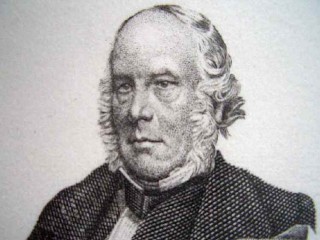
Rowland Hill biography
Date of birth : 1795-12-03
Date of death : 1879-08-27
Birthplace : Worcestershire, England
Nationality : English
Category : Arhitecture and Engineering
Last modified : 2011-10-10
Credited as : Inventor, Postage stamp, Teacher
3 votes so far
According to folklore, Hill began pondering postal reform after a conversation with a young woman, in tears because a postman had brought a letter from her fiancé but refused to deliver it when she was unable to pay the postage due. Until Rowland's time, the cost of postage was generally paid by the recipient, and rates were so expensive that mailed correspondence was a luxury beyond the means of ordinary working people. Furthermore, rates were complex, calculated by the distance and the number of pages, among other factors. Envelopes were rarely used, since the envelope counted as a page and added to the cost.
In 1837, Rowland Hill published Post Office Reform -- Its Importance and Practicability, which quickly went through several republications, making postal reform a leading issue of public debate. He proposed the sale of postage stamps, a novel idea described by Hill as "a small stamped detached label -- say about an inch square -- which, if prepared with a glutinous wash on the back, may be affixed." Hill argued that the rate should be low -- he suggested the "penny post" -- and offered calculations showing that postal rates could be greatly decreased and frequency of delivery increased, if all deliveries within England were charged at a single rate based on weight. He proposed that the sender should pay, which would reduce the "dead letter" problem of mail that could not be delivered, and he pointed out that this would lower costs and improve efficiency, since it was not uncommon for postal carriers to spend up to two-thirds of their time waiting for recipients to come to the door, and often waiting several minutes more as residents tried to find payment.
Five petitions were presented to Parliament in 1837 asking for Hill's reforms to be enacted, and more than 300 petitions were presented the following year, including dozens from local town councils and chambers of commerce. In 1839, as more than two thousand petitions were received, the Postmaster General finally endorsed Hill's proposals, which were passed into law on 5 December 1839, and took effect on 6 May 1840. Hill was appointed to an awkward newly-created position in the Treasury (not the Post Office), where he oversaw the implementation of his ideas.
The world's first postage stamp featured a flattering portrait of Queen Victoria. Costing one penny and good for up to half an ounce, the price allowed even poor people to write letters, and the volume of England's mail doubled almost immediately, and doubled again within a few years. Hill had also proposed publication of pre-paid postal stationery, which he thought would be more popular than the stamp, but on this point he was wrong. When a Tory government took power in 1842 Hill lost his position with Treasury and went to work for a railroad company. When Whigs took power in 1846 he was appointed to an executive post in the Post Office, where he worked for many years. He was knighted Sir Rowland Hill in 1860, died nineteen years later, and is buried in Westminster Abbey.
Hill's ideas were adopted virtually world-wide within a generation. In America, Senator Daniel Webster introduced postal reform legislation modeled on Hill's success on 10 June 1840, and the first US postage stamps were issued five years later. Hill's brother, Matthew Davenport Hill, was a member of Parliament and a prominent proponent of penal reform. Rowland Hill's son, Pearson Hill, invented the first mechanical postmarking machine, powered by steam and capable of canceling stamps on up to two letters per second.
















